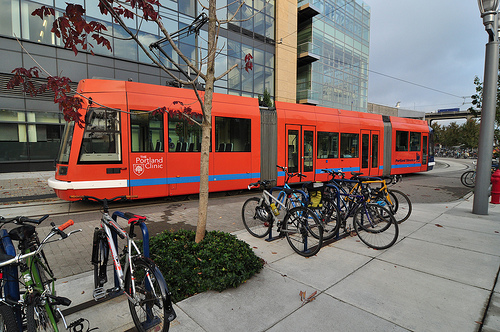
Fresh off of my trip to Railvolution, and with all the news, rumors and speculation swirling about here in Indy regarding Indyconnect’s final unveilings, I thought it would be a good time to address something that has received a lot of play in the local blogs and message boards; that being the role of streetcars. I will save bandwidth and skip the history of streetcars since I assume if you are visiting this site you have at least a passing knowledge of how streetcars enjoyed vast success in the early 20th century and were removed in the vast majority of North American cities by the 50’s.
In 2001, Portland was able to start reversing this trend by opening the first modern streetcar system in North America in decades. Sure there are vintage trolleys that operate in many cities but none with the frequency or utility of those of the old days. Most vintage trolleys are simply a curiosity or tourist attraction. They do not run with enough frequency to make them a mode of transportation that can be easily relied upon for daily service nor which can be used easily by the disabled, elderly or those with children.
The opening of the streetcar in Portland changed that. What they got was a European style “tram” that operated along city streets by the same rules as automobiles. They receive some signal priority at most intersections but by and large are subject to the same congestion issues as autos are. So why then, has it been so successful? What lessons can we learn from Portland’s modern streetcar service, and its expanding role in that community? What too, can we say about the future of the modern streetcar?
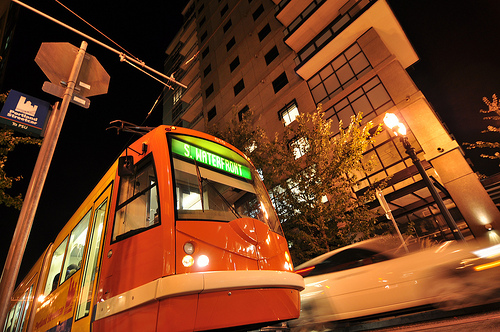
First, the initial goal of installing the streetcar in Portland was as a tool for economic redevelopment. The streetcar in Portland was built on top of an old rail yard with many warehouses and empty lots (Somewhat akin locally to the warehouses and empty lots along near north Capital & Illinois Ave.) Today, this is a neighborhood known as the Pearl district. In urbanist circles, it’s known as one of the great urban success stories of the late 20th century. Mixed use high rise buildings dot the neighborhood while people of all demographics and economic distribution mix in the area. Sure, there has been gentrification, but there has also been accomodation as the entire area isnt built out to top notch living standards. The area has been a magnet for economic development with over $3.5 billion in investment since the opening of the streetcar in 2001. Zoning changes have driven parking demands below 0.7 parking spaces per unit! That is a far cry from suburban oriented developments where you can see 2.5-3 spaces or more per unit. With the high cost of parking calculated into the equation at $20k a space, this means a cost savings for developers, and a cost decrease in overhead for potential tennants. All this mixed use hasn’t come without it’s own blood, sweat and tears. Most developers aren’t apt to build mixed income level of property without some sort of urging from government oriented bodies. To that end, the city has had to step in and mandate a mix of income for all people. Most developers will tell you that they build to “market rate” but in my experience that usually means upper-middle to upper class. There seems to be much work yet to be done in showing that the market can devour middle class urban core living.
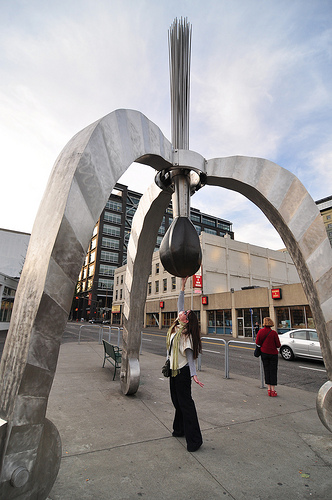
It is this high level of investment however, that has caused cities all over the country to get so excited about building their own modern streetcar system. Thus far, only Seattle has pulled it off, but many others are hot on their tail. Tuscon, AZ is currently working on their system as is Cincinnati. They have funding in hand and are actively moving forward with final design, utility relocation and other associated construction. Those communities too have hedged a bet that the opening of streetcar systems in their inner cities will serve to revitalize the neighborhoods that they travel too. For some perspective, the initial opening of the system in Portland, was about 2 miles round trip, and hosted 5 streetcar vehicles. A streetcar vehicle can hold from 150-200 people on a single car and at least in Portland, operate on a 15 minute headway. Not exactly rapid service, but enough to make it dependable and cause to leave the car keys at home to make a trip out to the store.
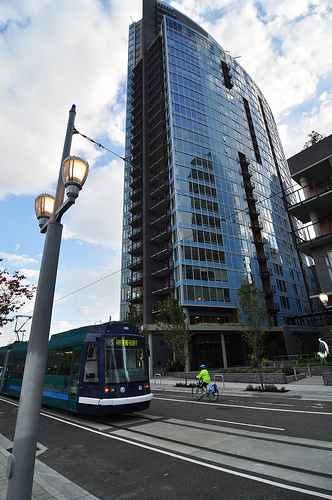
Some lessons can be learned from the way the Portland system was constructed, how it is maintained, and how they are planning and paying for it now, and its future expansion. The initial system was constructed at the behest of a group of citizens who formed a non-profit to facilitate the project. They lobbied the city and the city launched the campaign to get the streetcar built. They did not get much help from their local transit agency Tri-Met at the time. The thought of “slower service” wasn’t such an attractive selling point to a group who’s primary role is to move people from one place to another, as rapidly as possible. The city lobbied private land owners for donations and also used money generated from parking revenue in the downtown area to scrape enough funds together to build the first line, and buy the first set of vehicles.
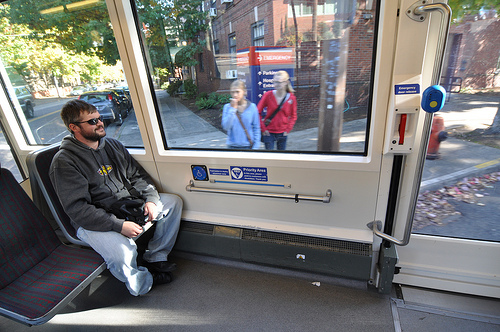
Over the next few years, more rail was laid and more cars were purchased. The line is now 4 miles long, and 10 cars strong and operating on 15 minute headways, while 12 minute headways can be expected during peak commuting hours and operating on a yearly operating budget of $5.6 million. It is a well oiled machine! Cities from all over North American visit to see how they could apply the success to their own cities.
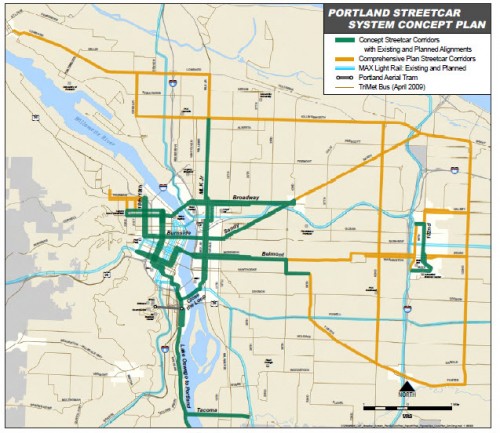
The last part I want to address however, is the future of the streetcar in America. I attended a workshop while at Railvolution about streetcars and their affects on neighborhoods. In this workshop, Patrick Sweeny with the City of Portland displayed a plan of expansion for the streetcar network in Portland (click to open 104 page plan in external window). It is still in the study phase, but service seems to be planned for a vast tract of Portland proper that would be geared more towards addressing commuting patterns rather than being a primarily economic development tool. Heavier travelled auto corridors are being pegged as routes for streetcar service. One of the concerns was that these arteries already serve heavy bus ridership numbers, so how would the streetcar be intermingled? The final choice seems to point to a more frequent streetcar service closer to the region’s core, while buses would still handle service futher out on the corridor. Essentially, buses would stop less frequently as they approached the core and existing riders of those buses would be urged onto streetcars to commute downtown. A scratching of each other’s back if you will. I, and others over the week, asked different questions about how to differently apply current streetcar technology. Can we link streetcars together like light rail vehicles? Is the Portland expanded plan going to look into different types of technology to serve it’s future plans? At the moment the answer is no. Using currently available technology like that operating in Portland seems to be the plan at the moment.
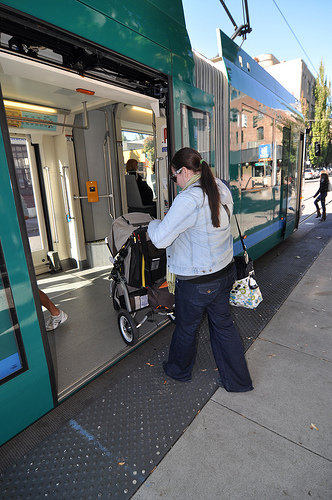
However, I personally challenge the industry to think differently. The possibility to link streetcar vehicles together exists. Operating them like light rail COULD offer some cost savings in the way of decreased infrastructre investment. One of the early selling points of the current streetcar was how quickly it can be completed with minimal construction down into the streets avoid costly utility construction. If this philosophy could be transferred to longer sets of streetcars (they are lighter loading per axle thereby not affecting current loading figures) perhaps a larger cross section of commuters could be captured while still offering the same quick construction patterns that are advocated today. Rick Gustafson addressed this point at a United Streetcar question & answer panel and stated the difference between light rail and streetcar construction is not largely different. However, if utility relocation is to be avoided, large benefit can be enjoyed. This however, remains to be challenged by those working in the field.

The Portland expansion plan however, IS ambitious. A regional survey showed the support was strong far from the regional core, which puts modern streetcar’s current peghole as an “economic development” tool at a paradigmn shifting point. Do cities continue to plan streetcar systems as an economic development tool only to try and help bring citizens back to their regional cores? Or do they look to them as commuting tools for those located further out from those same regional centers? Im not sure that anyone in the transit business has the answer to that yet. Even locals in Portland associated with the streetcar movement seem to be stuck in the “economic development” portion of the argument and look at the commuting option as something as an oddity if you will.
This seems ironic to me since the modern streetcar was seen as an oddity, or as locals called it, “The Donkey Trolley” when it opened. Critics aren’t pointing and laughing now, and I suspect as modern streetcar service enters it’s second decade of resurgence in America, that critics will be altogether silenced, and more cities will figure out the formula for offering an economic development tool and a commuting tool, all wrapped up into one bundle. I hope that as a citizen of Indianapolis, we can figure out how to apply both the economic development and the commuting capabilities of the modern streetcar.
Editor’s note: Please refrain from expounding on “They should build a streetcar here” types of replies.
 Thanks
Curt wrote “The streetcar in Portland was built on top of an old rail yard with many warehouses and empty lots (Somewhat akin locally to the warehouses and empty lots along near north Capital & Illinois Ave.)”.
.
We have a good example locally: the Clarian monorail. Look at the new healthcare, office, and research facilities built along its path…formerly a hodgepodge of parking lots and small warehouses and factories between IUPUI and Methodist.
.
The easy sell in a “no new taxes” state for a true public investment like streetcar (or other fixed-rail transit) is economic development and increases in property tax revenue driven by more-intense development.
Very true statement. In a sense it’s an informal public-private partnership.
See the comments on the Maxwell/Nature Conservancy post: a “node” development pattern and modern streetcar would go together well in Indianapolis.
I’d say the role is to reconnect urban neighborhoods and downtown together while also attracting development. What streetcars are not designed to do are act as a commute option for suburban residents. I’d like to see streetcar line extensions into depressed neighborhoods in the proximity of a downtown that is currently seeing grassroots efforts to improve it. I really think that a incorporating the role of a streetcar line would be huge in turning around such areas. Adding some new great urban neighborhoods in just under a decade is a great asset to boast.
A modern streetcar will be on display on Cincinnati’s Fountain Square starting at 1:00p Friday, November 5th through the afternoon of November 10th. You’ll be able to go inside and walk around. Representatives of its manufactuer, United Streetcar, will be on hand to answer your questions.
This particular vehicle is the first modern streetcar build in America since the 1930’s. It will soon join the fleet of Portland Streetcar Inc.
So come on over, see the streetcar, and take the world’s best ice cream home from Graeter’s, which has a store right next to where the streetcar will be postioned at Fifth and Walnut.
I wish I could make it. I got to walk through this same model at United Streetcar a couple of weeks ago though.
Kudos to Cincinnati for getting this entire project off the ground!
Kudos to Portland, but I think we should look at more European cities that have decades (if not a century) of experience with trams/streetcars. And I am not just talking about the Western Europe; as a matter of fact some of the best streetcar networks are in Central-Eastern European cities (for instance Prague, Vienna and Zagreb). You will find that streetcars connect high density areas with many shorter stops. Light rail and buses usually connect suburbs with downtown. In some cases, the streetcar networks were upgraded to light rail, but it seems that the streetcar networks are going through a period of revival with many European cities adding new lines. I also want to point out there are many different manufacturers of the streetcars. I think they should be made domestically if possible, but we need to keep our options open.
For some perspective, Portland – Indy – Zagreb are somewhat close in population size (however, of different density). Portland has 4-mile, while Zagreb has an 88-mile system with roughly 560,000 daily ridership. So, we need to look at those mature and extensive streetcar networks to answer many of our questions that might come up. Obviously we should look at Portland to see how to get things started here.
I would like to know if the image of the orange streetcar taken at night is a stock photo or was taken by a local photographer. We may be interested in using it, along with a few other Portland specific imagery, in a small run of brochures for the Portland Business Circle.